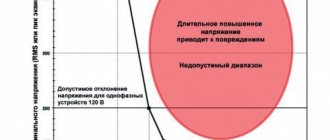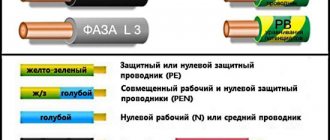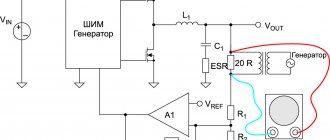Voltage sags can cause serious problems, such as disruption of production processes and loss of quality. Such failures occur much more often than interruptions. The economic consequences of voltage sags are often greatly underestimated. But what exactly is a voltage dip? How does voltage dip occur? Is it possible to prevent voltage sags or should we try to limit the possible damage through early detection? This article covers these issues in detail.
What is a voltage dip?
In accordance with the definition given in GOST 13109-97, this phenomenon means a sudden decrease in voltage amplitude followed by dynamic restoration of power within the nominal value. An example voltage drop waveform is shown below.
Voltage dip oscillogram
Characteristic indicators
To describe the decrease in voltage amplitude, the following indicators are used:
δUп is the depth of the dips, the following formula is used for calculation: δUп = (Unom - Umin) / Unom, where Unom is the nominal value of the amplitude of the supply voltage, Umin is the value of the residual voltage;
∆t – duration, this value is defined as the difference between the moment of voltage restoration to the nominal value tк and the time parameter for fixing the initial stage of deviation tн. The formula for calculating the duration will be as follows: ∆t = tк - tн
Fп – frequency of repetitions (frequency of failures), we present the formula used to calculate this parameter: Fп= 100% * m * (δUп* ∆tп) / M, where the numerator of the fraction describes the number of deviations of a certain depth and duration that occurred during measured period. The denominator is the total number of deviations detected during the measurements.
Main indicators of voltage dip
The above indicators are used to determine the quality of electricity in a particular power supply system.
Permissible voltage dips according to GOST
According to GOST 32144 2013, to determine power quality indicators, failures should be classified according to two criteria:
- The magnitude of the residual stress.
- Duration.
Since the occurrence of dips is random, no numerical values have been established for the criteria presented above. However, amplitude and duration measurements should be carried out in order to create a statistical array that allows one to establish the probability of a random event for a certain power network in order to characterize the FE.
As for “failures permissible according to GOST,” this phrase does not make sense, since failure means a deviation from the norm established by GOST (0.9 Unom). To be precise, we can call normalization the permissible duration of the dip (30 s), above which the deviation is considered to be a low voltage.
First steps. Slab countertops
Sano published a blog entry in Furniture made from slabs, solids, and various differences, October 6, 2022, blog entry
The first attempts to make something from the brought slabs. Although there may be some attempts, the material costs money and the right to make mistakes is as much as there is money in your pocket. Train at your own expense, as they say.
Therefore, each board is carefully inspected and tried on; the proverb about measure seven times is in action.
The work itself is not tricky, creative, there are several boards and they need to be selected so that they look beautiful and there is no overspending. All sizing and trimming is done with the minimum possible removal of material, simply sawed off a little here, cut a little there with a chisel.
Low voltage in the network: why does this happen?
Reduced or weak load on the electrical network for a private home is not uncommon. Also, very often there is not enough power for the dacha. This fact causes a lot of inconvenience, not to mention the fact that a person cannot use the help of a washing machine.
What to do in such a situation, where to call, complain, and most importantly, how to check the quality of the power supply yourself?
Insufficient voltage in the network is an extremely unpleasant situation, but almost everyone faces it. If the lighting is poor and the light bulb only indicates its presence, then this is not a big problem.
It will be worse when washing is not possible, boiling water is impossible, there is no way to cook food on an electric stove, or the refrigerator operates intermittently.
This often happens when the network voltage is less than 180 volts. If everything works at this voltage, then this does not have a very good effect on the devices and the operation process takes a longer time.
Let us highlight several main reasons for low voltage:
- The cross-section of the cable that enters the house is incorrect;
- The switch is not connected correctly;
- The substation transformer is rebooting or has partially failed;
- The cross-section of the main line is small;
- Skewed phases.
These were the most common reasons listed. If you understand that the cause of low voltage in your home is the same as in the 1st, 2nd or 6th point, then you can correct the cause yourself.
If the other 3 reasons or one of them suits you, then you should contact service stations.
Ways to solve the problem
It is necessary to start by identifying the reason that led to the “subsidence” of electrical energy. Let us describe in detail the algorithm of actions:
- You can start by asking your neighbors to determine if they have a similar problem. If they are faced with a similar situation, then there is a high probability that there is an external factor (weak transformer at the substation, problems with overhead lines or power imbalance). But before writing a collective statement to Energosbyt, you should check the internal network, so regardless of the survey results, we move on to the next point.
- Disconnect the input circuit breaker and measure the voltage at the input terminals, then repeat the measurement with the connected load.
The input circuit breaker is marked with a green oval
If the voltage is within normal limits without load, but after connecting the internal network it sags, then we can state that the problem is local in nature and will have to be solved on its own. First of all, it is necessary to check the input circuit breaker, since a weak contact at its input or output can cause a voltage “sag”.
What does low voltage in the network lead to?
- — significant deterioration in starting conditions for all types of engines and engine-based devices;
- — when starting the electric motor, the starting current increases;
- — overheating of the wires up to the melting of the insulation and the possibility of fire from a short circuit;
- - reducing the brightness of the lamps or their constant blinking, which leads to discomfort in living in the house;
- — reduction in the service life of household electrical appliances;
- — unstable operation of power-sensitive devices;
- — significant deterioration in the performance of electrical appliances.
Video about the laws of electrical engineering
From the following video you can learn what electricity is and the power of electric current. Examples of practical application of the laws of electrical engineering are given.
Electricity has long been used by humans to satisfy their needs, but it is invisible, not perceived by the senses, and therefore difficult to understand. Power, current, voltage, all these characteristics of electricity were studied by famous scientists who gave them definitions and described the mutual connections between them using mathematical methods.
Power current voltage resistance
It should also be remembered that the value of electrical resistance is influenced by several factors:
The table below shows general relationships for DC and AC circuits that can be used to analyze the operation of power supply circuits.
Low voltage (dip and sag)
- Connecting a powerful consumer (electric motor, compressor, etc.) to the network
- Temporary while troubleshooting other network problems
- Temporary drop in voltage amplitude. A failure differs from a sag in the duration of the problem: with a failure, the count is in sinusoidal periods (tenths of a second), and with a sag, the reduced voltage is observed for at least several seconds.
- If the voltage drops significantly, it is possible to turn off electrical equipment, restart the computer, etc.
Prevention and suppression measures:
- If possible, connect loads with high starting current via a dedicated line
- Reduced starting phenomena, for example by switching star/delta configurations
- The use of electronic devices such as inverters (frequency drives)
- In case of drawdowns, using a UPS will help
Bottom line
Voltage sags occur relatively frequently and are not always recognized. The economic damage from voltage sags is greater than from interruptions. By retrofitting the electrical infrastructure, a wide range of voltage sags can be prevented. Using uninterruptible power supplies or choking coils can reduce the damage caused by voltage sags. In some cases, these measures seem too costly. The first step, however, is always to recognize and document voltage sags. Janitza offers turnkey solutions that enable continuous monitoring and analysis of all production processes in a sustainable and reliable manner.
Through the use of modern measuring devices, problems related to voltage quality can be detected and eliminated in a timely manner. Improved power supply reliability is guaranteed, maintenance costs are reduced and the service life of the production plant is extended.
Increased voltage (surge, overvoltage)
- High Impedance Grounding Schemes
- Disabling a powerful consumer
- Phase breakdown in a three-phase network
- Uneven electricity consumption
- Temporary increase in voltage amplitude. A surge differs from an overvoltage in duration: a surge, similar to a dip, is a shorter fault (tenths of a second), and an overvoltage, similar to a sag, lasts at least several seconds.
- Data errors
- Flickering lighting
- Wear of electrical contacts and insulation
- Damage to semiconductor devices
- Increase in current strength and, as a result, tripping of circuit breakers
Prevention and suppression measures:
- The best protection is to use a UPS
How to free a person from the effects of ShN
It is possible to free the victim of step voltage from the effects of electric current only with the use of personal protective equipment and additional devices. These include:
- rubber boots or shoes with thick rubber soles;
- rubber electrical gloves;
- If possible, wear rubberized overalls;
- a wide dry board or better a wooden board;
- long stick.
Instructions for freeing a person from the effects of step voltage:
- Wear the above shoes and gloves.
- To approach a lying person, use boards or 2 shields.
- The rescuer holds one shield in his hands and walks further along the other flooring.
- Then he swaps shields. Thus, the rescuer moves towards the body of the electrocuted person.
- If a wire or cable is located near or on the body of a person affected by current, then it must be thrown with a stick in the opposite direction from you.
- The victim is placed on the shield and the flooring is gradually pulled to a safe place, not forgetting to step alternately onto the shields.
- After being delivered to a safe place, the victim is given artificial respiration and chest compressions without waiting for the ambulance to arrive.
Freeing the victim from the live conductor
Low voltage in the network: what to do, how to raise it, reasons
Without electricity today it’s like being without hands. It “gives life” to dozens of household appliances and lighting. The standard voltage in the network is 220 volts. Most electrical and lighting devices work with this. Sometimes the voltage suddenly drops by 40-60 volts.
This network state is considered critical, low. The wiring stops working properly. There is low voltage in the network, what to do, how to increase it? First of all, determine who the problem is coming from: the electricity supplier or consumer.
In the first case, collective letters and complaints will help, in the second - urgent and competent measures.
Where to call and complain about the power supply?
Calls cannot solve the current problem; it is necessary to file a claim for inadequate quality of services provided. That is, write a statement to the company providing electricity supplies (if the contract is concluded directly) or file a complaint with the management company. The application must be registered or sent by registered mail (mailing address is indicated in the contract).
If the above measures do not help, you can contact the prosecutor's office, Rospotrebnadzor, the district administration, the public chamber, as well as the district court.
Please note that collective complaints are more effective, so if neighbors or other residents of a house (district, village, etc.) are faced with a low voltage problem, then it is better to involve them in the process.
If, due to voltage deviations from established standards (due to the fault of the service provider), household appliances fail, you can demand compensation for the damage. To do this, you must follow the following algorithm:
- You should contact the service provider so that its representatives record that the accident occurred and draw up a corresponding report.
- A conclusion is taken from the service center, which indicates the reason for the failure of the household appliance.
- A claim is filed with the service provider seeking compensation for damages.
- If refused, the issue must be resolved in court.
- 2019
- 2018
- 2017
- 2016
- 2015
- 2014
- 2013
- 2012
- 2011
- 2010
- 2009
- 2008
Terms and definitions of poor quality power supply. Part 1.
The modern civilized world uses developments in the field of electronics in all areas: computers, laptops, industrial automation, smart home systems, data centers, etc. - all this, unlike old asynchronous electric motors and incandescent light bulbs, requires increased quality of consumed electricity. At the same time, it is known that the power grid is not always able to provide high-quality power supply. This article discusses terms that describe certain deviations in the power supply from the norm.
The Institute of Electrical and Electronics Engineers (IEEE) standard IEEE 1159-1995, IEEE Recommended Practice for Monitoring Electrical Power Quality, identifies several types of power disturbances, the most common of which are: :
1.Transient processes.
3.Voltage dips/voltage sags.
4. Voltage surges/overvoltage.
Frequency variations
- As a rule, there are no frequency variations in the electrical network. This phenomenon occurs much more often when powered from backup autonomous power sources, for example, a diesel generator set.
- The power frequency deviates from the standard 50Hz up or down.
- The greatest impact is on electric motors: changing the rotor speed. IT equipment is virtually unaffected.
- Reduced life of sensitive electrical equipment
Prevention and suppression measures:
- Diagnosis of relevant power supplies
- Using a UPS
Source
Power failure
- Damage (break) of the electrical network
- Electrical failure
- Protection triggered
- Complete absence of voltage in the network for some time (from milliseconds to several days in case of a major accident)
- Even a short-term power failure leads to a reboot of computer equipment with loss of unsaved data, or restart of an electric motor or compressor. This does not exclude their damage.
- Outages are especially dangerous in the industrial, medical and data center areas: in industry there are many non-stop processes, in medicine outages can disrupt the flow of an operation, and in the case of a data center it is downtime for a company's business.
Prevention and suppression measures:
- The most reliable way to solve problems with power outages is to use a UPS, one of the components of which is batteries. In the event of a power failure, the load is instantly powered from them (switching duration is less than half a cycle, i.e. less than 10 ms).
- It is almost impossible to solve the problem of long-term interruptions using rechargeable batteries due to the large size and high cost of such a solution. Therefore, sources of guaranteed power supply are used for critical processes. The most common of them are diesel generator sets (DGS).
Voltage drop on wires - distance from transformer to lamps or strip
We are often asked whether it is possible to move 12-volt LED lamps of such and such power in such and such quantity away from the transformer at such and such a distance?
The general recommendation is that this distance should not exceed 5 meters. This is a known fact.
But what if you need more than 5 meters? Often, due to design limitations, it is impossible to meet such a short distance.
Wire losses are the essence of the problem
In some situations, you can turn the number 5 into a much larger value. To do this, you need to estimate the voltage drop across the wires.
This is what causes the limitations - the wire itself has internal resistance and therefore “eats” part of the voltage of the current source. And when the wire is too long, it can happen that the lamps are left with such a small part of the original voltage that they do not light up.
The second part of the problem is that the wire does not just “eat up” part of the voltage, but turns it into heat. In addition to the fact that this is simply a stupid waste of electricity, it also poses a fire problem - the wire can heat up too much.
To be sure that the required, for example, 15 meters between the transformer and the lamp will not cause trouble, you need to estimate exactly how many volts will be lost over these 15 meters.
Calculating the voltage drop across a wire is very simple. As a rule, you have all the data necessary for this: wire length, total power of connected lamps (strips), supply voltage and cross-sectional area of the conductor. You just need to additionally find out the electrical resistivity of the material from which the wire is made.
Formula for calculating voltage drop across wires
It is quite easy to derive a simple general formula for calculating voltage drop, applicable in any situation.
We only need Ohm's law R = V / I and the formula for the relationship between electrical power, voltage and current W = V · I.
Also, to estimate the resistance of a wire, you need to know the value of the electrical resistivity [Wikipedia] of the conductor material.
Having carried out simple calculations, we obtain the following formula, which gives an estimate of the value of the voltage drop on the wires:
Estimation of voltage drop on wires
The voltage drop depends on the type of wire material, wire cross-section, its length, consumer power and power source voltage. This formula indicates:
- W is the power in watts of the current consumers at the end of the wire;
- V is the voltage of the current source in volts, usually 12 volts or 24 volts;
- L is the length of the wire in meters, i.e. distance of consumers from the transformer;
- S is the cross-sectional area of the wire in mm²;
- ρ is the value of electrical resistivity in Ohm mm²/m, for copper it is approximately 0.018 Ohm mm²/m
The formula is simple, but only applicable if the expected voltage drop is small, no more than a few percent, i.e. when the distance between the transformer and the consumer does not exceed 10 meters, and the power is less than 10-20 watts.
In other cases, you should use a more precise formula:
The exact voltage drop across the wires
Now, having calculated the voltage drop across the wires, we can estimate how much power will be lost - simply spent on heating the wires. It is necessary to multiply the resulting value of the voltage drop by the power of the current consumers W and divide by the transformer voltage V :
Estimation of power drop on wires
If this power turns out to be too large, then, obviously, you need to increase the thickness of the wire. Otherwise, you can get into various troubles, including a fire.
conclusions
As is easy to see from the formulas, doubling the cross-sectional area of the conductor approximately doubles the voltage drop across the wires
.
Another possible solution to the problem may be to increase the voltage value of the current source. If, of course, current consumers allow it. Again, doubling the supply voltage roughly halves the voltage drop
.
For example, our low-voltage E27 lamps for 12-24 volts produce the same light from both 12 and 24 volts. And in this case, it makes sense to switch to a 24 volt transformer.
It also becomes clear that for powerful consumers (about 100 watts) very thick wires will be needed.
Example
Let's estimate the voltage drop on a copper wire with a cross-section of 1.5 mm² and a length of 20 m at 24 volts and a power of the connected tape of 50 watts.
Substituting these values into the first formula, we get that about 1 volt and about 2 watts are “lost” on the wires. In principle, this is not much, but if it is possible to increase the thickness of the wire, it is better to do so.
Transients
Pulse transients (electrostatic discharge)
- Thunderstorm: both the case of a direct hit and discharges in the sky affecting the power grid through an electromagnetic field
- Switching inductive loads
- Triggering of protective automation
- Ground fault
- A pulse transient process is a sharp voltage surge of several kilovolts (the duration of the surge is nanoseconds, the total duration of the disturbance is tens of nanoseconds)
- Electrostatic discharge does not harm a person (apart from the unpleasant crackling sound and spark), but “kills” any microcircuit
Prevention and suppression measures:
- Maintaining indoor humidity in the range of 40-60%
- Antistatic grounding (bracelets, mats, shoes)
- General grounding
- Surge suppression devices:
- based on metal oxide varistors that suppress surges of any duration)
- thermal protection
- gas arresters
- thyristors











